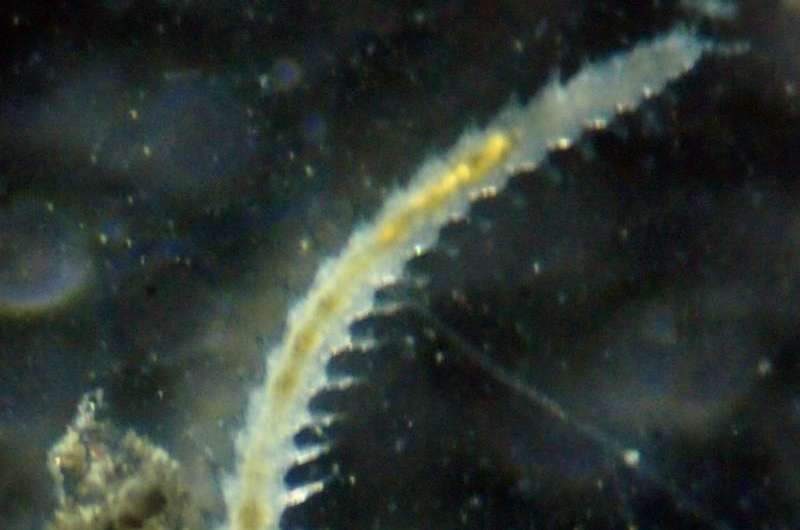New species of marine worm discovered on Antarctica's Deception Island

Parougia diapason is the name of a new marine invertebrate species discovered on Deception Island (South Shetland Islands), in the Southern Ocean. An article published in the journal Polar Biology describes the finding.
The new species is part of a group of marine worms (polychaetous annelids) that commonly occur in marine seabeds rich in organic matter from both natural and anthropogenic origin at different latitudes. To be precise, P. diapason is the second species of the genus Parougia discovered in the Southern Ocean (P. furcata was described in 1953 by O. Hartman).
A new species on the seabed of Deception Island
Experts identified this small marine worm in bones of a common minke whale (Balaenoptera acutorostrata) in Port Foster shallow waters, on Deception Island, close to the Gabriel de Castilla Spanish Antarctic base, but also in association with organically enriched sediments nearby. "The Antarctic Peninsula and South Shetland Islands are a widely studied area. However, few species have been described so far on Deception Island," says Professor Conxita Àvila, head of the multidisciplinary project DISTANTCOM, which studies chemical ecology, phylogenetics, phylogeography and trophic ecology in the Antarctic continent.
Marine worms that feed on whale bones: live after death
According to researcher Sergi Taboada, first author of the article, "Tthere are few scientific studies centred on marine invertebrate communities associated with whale bones in the Antarctic. Our group is pioneering these types of studies, which are also being developed in other Earth regions."
Experts have carried out morphological and phylogenetic analyses (with nuclear and mitochondrial genetic markers) to determine the new species. Evidence suggests that it is the most ancient species of the genus Parougia. The species presents some morphological traits, including lack of a dorsal cirrus and some unique morphological characteristics related to the jaw apparatus, that distinguish it from the rest of the congeneric species described so far.
"The study provides comprehensive information about the new species, not only from a morphological and ecological point of view, but also places the species in its phylogenetic context," says Taboada. "In the past, this type of information was not available, but lately, it is more and more common to find species descriptions that include a phylogenetic tree. Moreover, this kind of information is collected on public databases that every interested researcher can consult."
Parougia diapason, an opportunistic species
One of the most interesting scientific aspects is the ecology of the species discovered in the Antarctica. These organisms populate areas rich in organic matter, both from natural and anthropogenic origins.
"It seems that P. diapason is an organism that signals any kind of environment alteration, like a significant increase of organic matter," says Taboada. "The species is a clear example of an opportunistic species, in other words—an organism that profits from an excess of organic matter, which favours its proliferation and population density." Knowledge of these ecological characteristics is crucial as it allows detecting environmental changes in an indirect way.
There is not much scientific literature about Antarctic marine benthic organisms that proliferate in eutrophic habitats (those rich in organic matter). There are some studies centered on anthropogenic activity impact in the McMurdo base, the largest American scientific base in the Antarctica, to monitor marine invertebrate communities in the area where waste water was dumped.
Antarctic species discovery and protection
The UB-IRBio research team has made other significant discoveries of Antarctic marine invertebrates, for example, the two first bone-eating worms of the genus Osedax, or the nemertean Antarctonemertes riesgoae that has a unique reproductive strategy. However, scientists say that there is still much work to do in order to explore, discover and protect Antarctica.
"It is necessary to continue studying new species and to do our best to protect them," says Conxita Àvila. "The Antarctic has very special habitats that are difficult to study; measures must be maximized in order to avoid, for instance, anthropogenic pollution and tourism impact."
"Any change can affect Antarctic regions but we do not have enough data yet. However, it is certain that these changes can cause the extinction of species that remain unknown and unstudied. Besides biodiversity loss, species extinction means missing the opportunity to study the chemical products they produce, which may be molecules with potential biological interest," alerts Conxita Àvila.
More information: "A new Parougia species (Annelida, Dorvilleidae) associated with eutrophic marine habitats in Antarctica." Polar Biology, April 2015, Volume 38, Issue 4, pp 517-527 DOI: 10.1007/S00300-014-1614-7
Provided by University of Barcelona



















